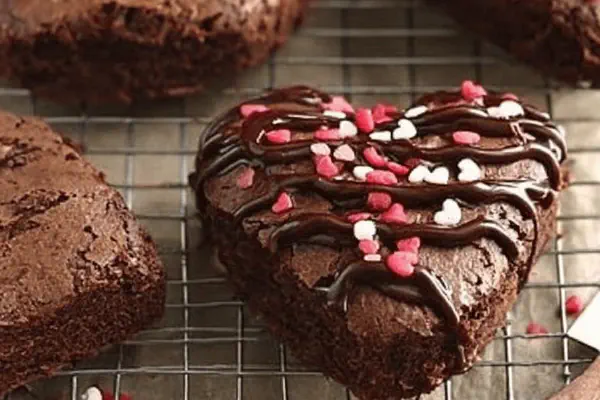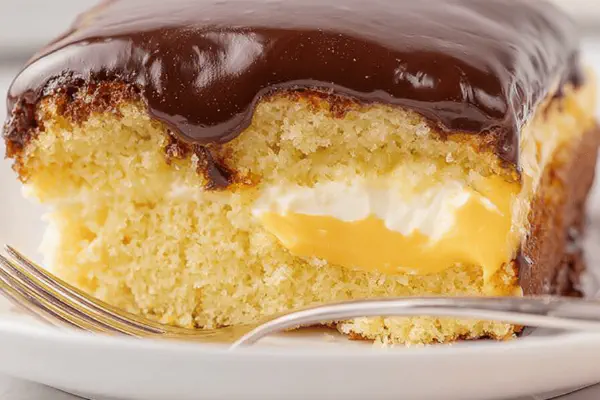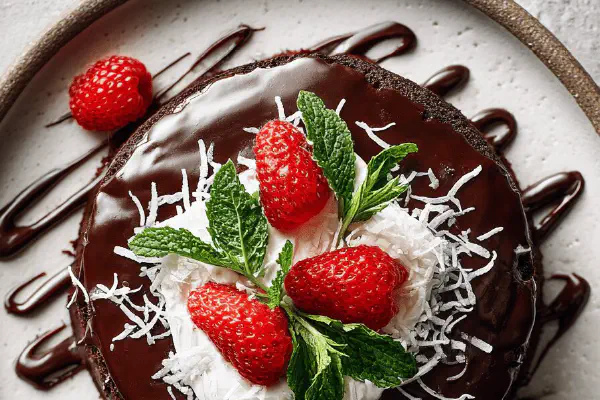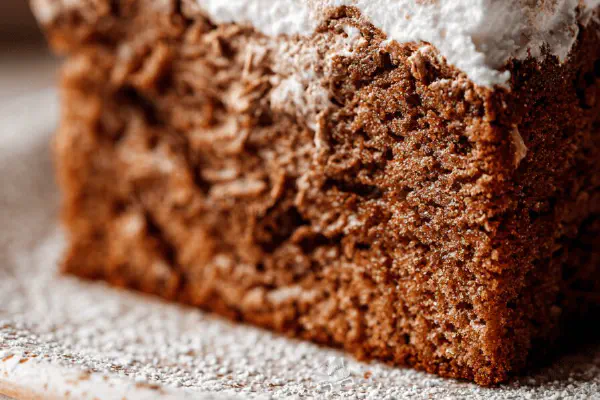S'mores Cake Remix
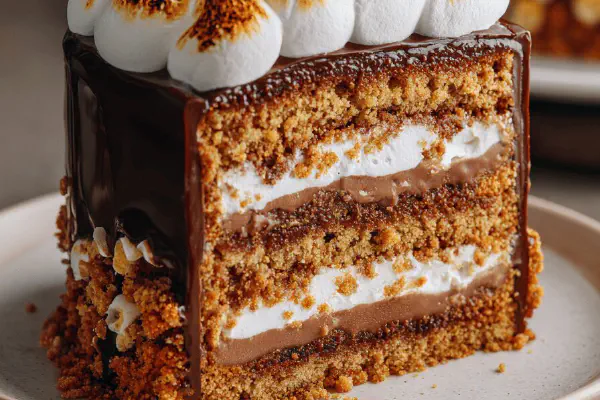
By Emma
Certified Culinary Professional
Ingredients
Cake
- 395 ml (1 2/3 cups) unbleached all-purpose flour
- 300 ml (1 1/4 cups) graham cracker crumbs, slightly coarser than store-bought
- 16 ml (1 tbsp plus 1 tsp) baking powder
- 2,5 ml (1/2 tsp) salt
- 4 large eggs
- 390 ml (1 2/3 cups) granulated sugar
- 5 ml (1 tsp) vanilla extract
- 180 ml (3/4 cup) refined coconut oil (sub for canola oil)
- 310 ml (1 1/4 cups) whole milk
Ganache
- 220 g (7 3/4 oz) chopped milk chocolate with 35% cocoa
- 175 ml (3/4 cup) 35% heavy cream
Marshmallow Topping
- 10 ml (2 tsp) gelatin powder
- 125 ml (1/2 cup) cold water
- 130 ml (1/2 cup plus 1 tbsp) granulated sugar
- 50 ml (1/4 cup) clear corn syrup
- 5 ml (1 tsp) vanilla extract
About the ingredients
Method
Cake
- 1. Center oven rack mid-level. Preheat oven to 175°C (350°F). Butter two 20 cm (8-inch) springform pans. Line bottoms with parchment. Why? Prevents uneven browning and sticking—vital for delicate crumb.
- 2. Mix flour, cracker crumbs, baking powder, salt in a bowl. Coarser crumbs carry more crunch, watch not to overdo or crumb falls apart.
- 3. In mixing bowl, beat eggs, sugar, vanilla on high for 9-11 mins till volume triples, ribbon stage visible when lifting whisk. This is key for air, skip and cake falls flat.
- 4. Stream coconut oil slowly while beating; oil warms and integrates smoother than cold butter or canola oil here. Reduce mixer speed, alternate adding dry mix and milk in three parts, beginning and ending with dry. Don't overmix or crumb dulls and toughens.
- 5. Pour batter evenly, tap pans to release air bubbles. Slide into oven promptly. Bake 38-43 mins. Test with toothpick; clean or few moist crumbs—not wet batter.
- 6. Cool pans on rack 15 mins, then run knife around edges, unmold cakes. Let cool fully on rack before assembly. Avoid residual heat or ganache melts prematurely.
Ganache
- 7. Place chopped chocolate in heatproof bowl.
- 8. Heat cream to near boil, just before rolling boil, pour over chocolate. Rest 1 min — don’t stir yet; waiting ensures melting without seizing.
- 9. Whisk gently till silky, glossy. Cool 2-3 hours or until spreadable consistency. Stir every 30 mins prevents skin forming. If too fluid, refrigerate briefly, return to room temp to soften.
Assembly
- 10. Trim domed tops from cakes for flat stacking.
- 11. Slice one cake horizontally into two layers with serrated knife or cake leveler; steady hands avoid crumb breakage.
- 12. Place whole cake layer on serving plate. Spread half ganache evenly—thick enough to taste but not heavy.
- 13. Add sliced cake layers one on top of another separated by remaining ganache. Press slightly to settle but don’t squish layers.
Marshmallow Topping
- 14. Sprinkle gelatin over cold water in saucepan, bloom 5-7 mins until gelatin swells and absorbs water.
- 15. Add sugar and warm gently, stirring until dissolved and gelatin melts completely. Avoid boiling to preserve gelatin strength.
- 16. Transfer syrup to mixer bowl; add corn syrup and vanilla immediately. Whip on high 9-12 mins till mixture forms semi-firm glossy peaks, shiny but with some viscosity.
- 17. Pour immediately over assembled cake, letting it cascade naturally. Don’t spread - drips and swirls give rustic charm.
- 18. Using kitchen torch, brown the marshmallow unevenly, listen to faint crackle, watch for toasted golden patches, avoid burning bitter black spots. If no torch, use broiler flakes cautiously from distance.
- 19. Keep cake covered loosely at room temp. Cooler temps firm top but never refrigerate—marshmallow toughens and weeps under cold.
Tips & Tricks
- Baking times vary per oven; always trust visual and tactile clues — springy top, firm edges, toothpick test. Coconut oil adds moisture but also distinctive aroma; if allergic, substitute light olive oil but expect subtle flavor shift.
- For ganache, chocolate percentage can sway firm versus runny consistency. Milk chocolate here chosen for sweet, creamy contrast. Darker means firmer ganache but more bitter.
- Marshmallow topping sets better if everything is dry and room temp. Humidity can turn it sticky—if so, a quick torch pass before serving reenlivens shine and crunch.
- If stacked cake steps are wobbling, chill 15 mins before topping. Faster assembly keeps marshmallow pliable and glossy.
- Watch timing stringency loosened to encourage eye and finger sense development. Heat zones and altitude mess with clocks; your nose, touch, and visual intuition always best guides.
- Storage: keep at ambient temp covered in cake dome or loose foil wrap. Avoid fridge—the marshmallow turns rubbery and the crust gums up.
- Common fail: rushing egg beating kills volume. Slow gradual folding keeps batter aerated. Overbaking dries cake, underbaking leaves sunk center. Look for shimmery cratered batter surface just before total set.
- Patience in ganache cooling pays in silken spread, no clumps. Stirring develops gloss and avoids grainy texture. Skip this and you get dull, flaky mess.
- The toasted marshmallow scent—the finale—signals all done. A few extra seconds under the torch add caramelized notes that shift this from simple to sublime.
Cooking tips
Chef's notes
- 💡 Eggs beaten long till volume triples—ribbon stage matters. Skip this and cake falls flat; air trapped is key. Coconut oil warms when pouring, smoother blend than cold fats. Alternate flour and milk additions, always start and end dry. Overmixing kills crumb texture, toughens gluten. Batter texture feels right when thick yet pourable, no lumps, no streaks.
- 💡 Gelatin blooms slow—5 to 7 mins cold water necessary. Stir sugar gently to dissolve completely, avoid boiling; high heat ruins gelatin strength. Whip marshmallow till shiny soft peaks hold but still bend. Too stiff, topping heavy no drizzle; too soft collapses. Torch over marshmallow to speckled gold, listen for faint crackle. Broiler substitute but distance and caution crucial.
- 💡 Ganache patience pays off. Pour cream hot but not boiling to chocolate, rest one minute before stirring; prevents seizing. Stir gently till glossy. Cool couple of hours, stir periodically to avoid skin—skin ruins spread. Too fluid, chill briefly then warm room temp to soften. Chocolate choice shifts texture—milk chocolate sweet and creamy; dark for firmer ganache but more bitterness.
- 💡 Bake 38 to 43 mins, test toothpick—wet batter ruins crumb but too dry crumb means overbaked. Oven rack centered mid-level matters. Butter pans and parchment prevents sticking, otherwise disaster. Cool cakes fifteen mins in pans, then unmold. Warm ganache and marshmallow topping melt if cake too warm. Cooling rack crucial step.
- 💡 Stacking: level with serrated knife. Slow sawing avoids crumbs falling apart. Press layers slightly, no squish. Marshmallow topping poured straight, no spread; natural drips add rustic look. Store loosely covered room temp only. Refrigeration dries marshmallow; humid kitchen sticky topping—quick torch pass before serving fixes tackiness. Cake wobble? Chill 15 mins before topping.
Common questions
What if eggs not beaten long?
Cakes will fall flat, no airy crumb. Volume low, batter heavy. No ribbon stage seen. Air trapped stops. No shortcuts. Alternate is whipping whites separately but added complexity.
Can I swap coconut oil?
Light olive oil ok, flavor shifts subtle but noticeable. Butter changes texture more. Avoid cold oils, emulsions break. Temperature control helps but expect slight difference in moistness, aroma. Remember refined coconut picked to minimize heavy flavor.
Why dense ganache?
Overheating chocolate or too much cooling time without stirring causes grainy. Stir regularly while cooling. If too firm, add cream gently and whisk. Chocolate type influences firmness. Darker means firmer, milk softer. Reheat gently if too stiff.
How store cake?
Room temperature best, loosely covered avoiding humidity. Foil wrap after cooling. Refrigerate ruins marshmallow texture, turns rubbery. Cooler environment firms top but no fridge. Leftovers okay 2-3 days with care—moisture key. Freeze not recommended; texture soggy after thaw.
